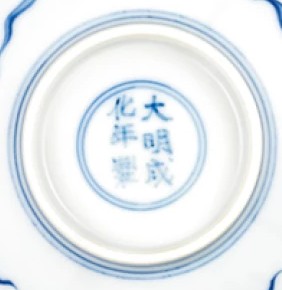
Reign mark, nianhao, of a Chenghua period blue-and-white 'palace bowl' from the early part of the reign, likely used at court for food.
The Chinese imperial six-character marks on the bases of antique Chinese porcelain are in older literature often referred to as a Nianhao. This means specifically the general title of any reign of any Chinese Emperor, and should not be confused with the last two characters that say nianzhi (年制), meaning "made during the reign of".
The Nianhao (reign name) of for example the Chenghua period of the Ming dynasty was "accomplished change" and would usually read Da Ming Chenghua Nianzhi (1464-1487) meaning "Made during the Chenghua reign of the Great Ming [Dynasty]" or translated in full "Made During the Era of Accomplished Change of the Great Bright [Dynasty]".
Thus, the Nianhao refers to the reign title itself, while Nianzhi simply mean "period made," appearing at the last two characters of the mark to denote the period during which the item was produced.
A